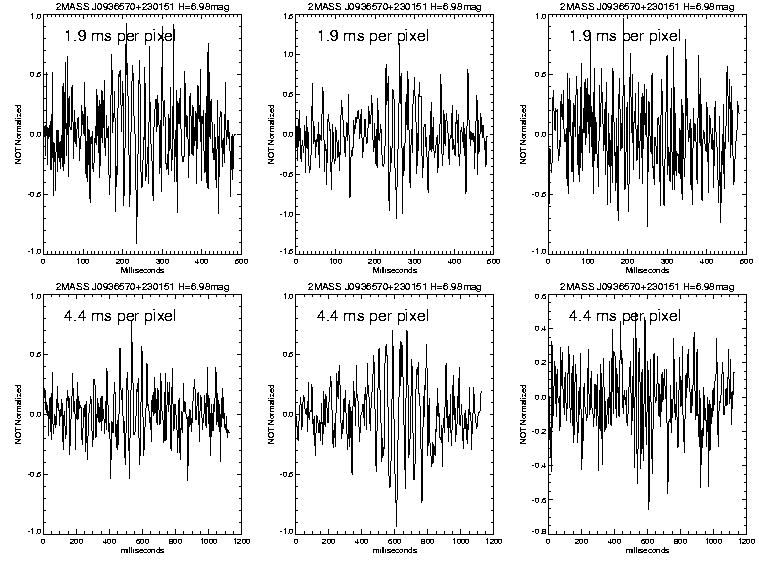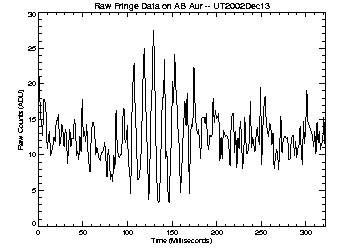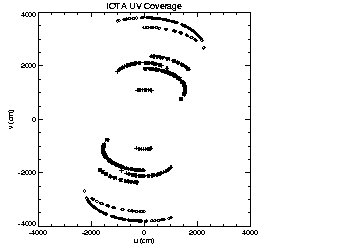IOTA - IONIC see YSOs with Three Telescopes (December 2002)
A new milestone has been reached at
IOTA.
Following
first fringes in February/March 2002 with the new three-telescope
system, the commissioning of the new IONIC
three-way beam combiner took place early in December. This newly improved version with
increased throughput has allowed to match the very good past sensitivity
of the two-telescope IOTA, in spite of the additional light splitting
required for three-beam combination. The figure below, shows H-band
interferograms of the star 2MASS J0936570+230151, of Hmag = 6.98.

Raw interferograms obtained on the star 2MASS J0936570+230151, demonstrating adequate signal-to-noise ratio for this relatively faint star. The three panels correspond to each of three baselines of an IOTA configuration (for each fringe shown, two complementary beam combiner outputs have been scaled and subtracted). Top and bottom panels correspond to two different readout modes of the PICNIC science camera: on good seeing nights, integrations as long as 4.4 msec per data point are possible! Our fringe tracker allows simultaneous detection of the three fringes, making closure phase measurements possible.
With its new limiting magnitude, its three telescopes and
its ability to change its baseline configuration, IOTA with IONIC has become
the first long baseline interferometer with the capability of imaging
protoplanetary environments with sub-astronomical unit resolution. Moreover, the
IONIC combiner with its spatial-filtering properties and photometric
calibration ability should allow measurements more precise than usual. A
collaboration between researchers from several institutes contributing to IOTA
has already started and aims at observing several young-stellar objects.
|
|

|
Participants to the IOTA
YSO program : (left to right) J.P. Berger (LAOG), J. Monnier
(U. Michigan), F. Malbet (LAOG) and R. Millan-Gabet (Caltech/MSC).
The following figures show (left) a typical
interferogram obtained for the intermediate-mass young star AB
Aurigae (Hmag=5.2), and (right) the spatial frequency (u,v) coverage obtained on this source
using two different IOTA configurations in December 2002. By measuring visibility amplitudes
and closure phases on such relatively well sampled uv plane, our aim
is to model in detail the physics and morphology of these
circumstellar environments, as well as attempt to reconstruct
model-independent images.

|

|
Typical interferogram measured on the young Herbig Ae star AB Aurigae,
and (u,v) coverage obtained on this source in December 2002 using two IOTA configurations.
The IONIC combiner (see photo below) has been developed by
the IONIC collaboration, an association between three french labs: LAOG
(Laboratoire d'Astrophysique de Grenoble), IMEP (Institut de Microelectronique
Electromagnetisme et Photonique) and LETI
(Laboratoire d'Electronique, de Technologie de l'Information). This collaboration was set up to
apply integrated optics technology to astronomical interferometry. These
technologies allow to embed single-mode optical circuits on circuits a
coin-sized chip. One of the reason for this new IOTA success is that, unlike
the previous one, the new combiner does not require polarizing the signal in
order to obtain maximum instrumental contrast. A particular care was taken to
control differential effects in the fibers and at the interface between fibers
and the integrated optics chip.

The integrated optics three-beam pairwise beam combiner (manufactured by LETI) on its mount. To the right of the figure, light from each IOTA telescope is input via single-mode optical fibers. Pair-wise beam combination takes place inside the component, and 6 combined beams emerge from the left and are focused onto 6 separate pixels of the new IOTA PICNIC camera.
As always, we acknowledge the CfA and UMASS members of the
IOTA collaboration who were not on site, but supported actively this
ongoing effort:
IOTA CfA Team: W. Traub, N. Carleton,
M. Pearlman, E. Pedretti,
M. Lacasse, A. Ahearn, S. Ragland. IOTA UMASS Team: P. Schloerb, M. Brewer,
K. Souccar, G. Wallace.
We would like also to thank numerous people in Grenoble for their hard work on
design, manufacture and testing of the beam combiners:
LETI IONIC team: P. Labeye, S. Gluck. IMEP IONIC team: I. Schanen, F. Rooms, P. Benech and J.E.
Broquin LAOG team: P. Kern, K. Perraut, F. Malbet, J.P Berger, P.
Haguenauer, L. Lagny, B. Arezki, A. Delboulbe and L. Jocou.